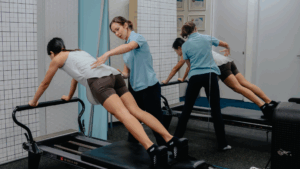In this comprehensive guide, we’ll cover everything you need to know about piriformis syndrome, including the role of physiotherapy, specialised techniques, what to expect during your sessions, the number of sessions required, and even some lifestyle changes and home exercises to complement your pain management. Let’s get started!
What is piriformis syndrome?

Piriformis syndrome is a condition characterised by pain, tingling, or numbness in the buttocks that can radiate down the back of the leg. This discomfort is often caused by the compression or irritation of the sciatic nerve as it passes through or under the piriformis muscle.
What are some common symptoms of piriformis syndrome?
- Buttock pain: This is the hallmark symptom of piriformis syndrome. The pain is often described as deep and aching.
- Radiating leg pain: The pain can extend down the back of the thigh and even reach the calf.
- Tingling or numbness: Some individuals may experience a sensation of pins and needles or numbness in the leg.
- Aggravation by activity: The symptoms may worsen with prolonged sitting, walking, or climbing stairs.
How can physiotherapy help those with piriformis syndrome?
Physiotherapy plays a crucial role in the management of piriformis syndrome. It’s a conservative, non-invasive approach that aims to alleviate pain, improve mobility, and enhance the overall quality of life for individuals suffering from this condition. Here’s how physiotherapy can help:
1. Pain management
Physiotherapists are trained to identify the source of your pain and develop a tailored pain management plan. Through manual therapy techniques, exercises, and other interventions, they can target the piriformis muscle and surrounding structures to alleviate pain.
2. Muscle relaxation
In piriformis syndrome, the piriformis muscle can become tight and contribute to nerve compression. Physiotherapists employ various techniques, such as stretching and manual therapy, to relax this muscle and reduce compression on the sciatic nerve.
3. Strengthening and stabilisation

Weakness in the gluteal muscles can exacerbate piriformis syndrome. Physiotherapy involves exercises to strengthen these muscles, improving support and stability in the hip region.
4. Posture and body mechanics
Poor posture and incorrect body mechanics can contribute to the development of piriformis syndrome. Physiotherapists can educate you on proper posture and movement techniques to reduce strain on the piriformis muscle.
5. Education
Understanding the condition is crucial for its management. Physiotherapists educate patients about piriformis syndrome, its causes, and how to prevent exacerbation.
What specialised techniques do physiotherapists use to address piriformis syndrome?
Physiotherapists employ a range of specialised techniques to address piriformis syndrome effectively. Here are some of the key methods used in physiotherapy sessions:
1. Manual therapy
Manual therapy is a form of hands-on physical therapy that uses various techniques to diagnose and address medical problems. The techniques include kneading and manipulation of muscles, joint mobilisation and joint manipulation.
- Soft tissue massage: Targeted massage techniques can help relieve muscle tension and improve blood flow.
- Joint mobilisations: Gentle movements applied to the affected joint can restore mobility and reduce pain.
- Trigger point release: Therapists locate and release trigger points, often found in the piriformis muscle.
Tip: Learn more about how
2. Stretching
Stretching is an integral part of the physiotherapy process for piriformis syndrome. It helps to improve flexibility, reduce muscle tension, and alleviate the compression on the sciatic nerve. Key stretching exercises include:
- Piriformis stretch: A specific stretch that targets the piriformis muscle and helps reduce compression on the sciatic nerve.
- Hip flexor stretch: Tight hip flexors can contribute to piriformis syndrome; stretching them is often beneficial.
3. Strengthening exercises
Strengthening exercises play a vital role in the rehabilitation process. They focus on strengthening specific muscle groups to provide better support and stability to the hip joint. These exercises typically include:
- Gluteal strengthening: Exercises that specifically target the gluteal muscles. A stronger gluteal region can provide better support to the hip joint, reducing strain on the piriformis muscle.
- Core strengthening: A strong core is essential for maintaining proper posture and body mechanics, which is particularly important for those with piriformis syndrome.
4. Nerve flossing
Nerve flossing is a specialised technique that physiotherapists use to mobilise the sciatic nerve gently. This method helps reduce irritation caused by the piriformis muscle’s compression on the nerve. By incorporating nerve flossing into the session plan, physiotherapists aim to improve nerve function and alleviate associated symptoms.
5. Postural training
Poor posture can contribute to the development and exacerbation of piriformis syndrome. Physiotherapists assess your posture and provide guidance on making necessary adjustments to reduce strain on the piriformis muscle. Postural training is an essential component of long-term management to prevent recurrences of the condition.
What can you expect during a physiotherapy session for piriformis syndrome?

If you’re considering physiotherapy for piriformis syndrome, you might be wondering what to expect during your sessions. Let’s walk you through a typical physiotherapy appointment:
1. Initial assessment
Your first session will begin with a comprehensive assessment by the physiotherapist. They will ask you about your medical history, your current symptoms, and any previous treatments you’ve tried. This initial assessment helps the physiotherapist understand your specific condition and needs.
2. Individualised session plan
Based on the assessment, your physiotherapist will create an individualised session plan. This plan may include a combination of manual therapy, stretching exercises, strengthening exercises, and education on posture and body mechanics.
3. Hands-on techniques
During the session, the physiotherapist may use various manual therapy techniques to target the affected areas. These hands-on techniques aim to alleviate pain, reduce muscle tension, and improve mobility.
4. Exercise prescription
You’ll receive a tailored exercise program to address your specific needs. The physiotherapist will guide you through each exercise, ensuring you perform them correctly to maximise their effectiveness.
5. Progress tracking
As you continue your physiotherapy sessions, your progress will be closely monitored. Your physiotherapist will make adjustments to your management plan as needed, ensuring you’re on the path to recovery.
6. Education
Throughout your sessions, your physiotherapist will provide you with valuable information about your condition. You’ll learn about piriformis syndrome, its causes, and how to prevent future episodes.
How many sessions are typically needed for effective management of piriformis syndrome?
The number of sessions required for effective management of piriformis syndrome can vary from person to person. It depends on several factors, including the severity of your symptoms, your response to the exercises, and your commitment to the prescribed exercises and lifestyle changes. Generally, patients can expect to attend physiotherapy sessions for several weeks. Here’s a rough guideline:
- Mild cases: If your symptoms are mild and you respond well to addressing your pains, you might require as few as 6-8 sessions.
- Moderate cases: In cases with moderate symptoms, patients typically benefit from 10-12 sessions.
- Severe cases: Severe piriformis syndrome may necessitate 12 or more sessions to achieve optimal results.
It’s important to remember that consistency in attending sessions and diligently following your home exercise program will have a significant impact on the success of your session. Your physiotherapist will monitor your progress and adjust the session plan accordingly.
Relieve pain from piriformis syndrome at City Osteopathy & Physiotherapy
Piriformis syndrome can be a painful and limiting condition, but with the right approach, relief is within reach. Physiotherapy is a valuable tool in managing this condition, helping you regain mobility and improve your quality of life. By working closely with a qualified physiotherapist, making necessary lifestyle adjustments, and incorporating home exercises, you can take positive steps towards overcoming piriformis syndrome.
Here at City Osteopathy & Physiotherapy, we are committed to helping you live your life to the fullest, free from pain and discomfort. With 5 clinics across Singapore and over 12 years of experience, we’ve helped more than 15,000 patients to get better and enjoy their best everyday. Book a consultation with us as we tailor an integrated plan to manage your piriformis syndrome effectively.
Other piriformis syndrome FAQs
Besides physiotherapy, what lifestyle changes can help with piriformis syndrome ?
Making certain lifestyle changes can enhance the effectiveness of your physiotherapy for piriformis syndrome. Here are some recommendations:
1. Ergonomic adjustments: If your job involves prolonged sitting, make ergonomic adjustments to your workspace. Ensure that your chair and desk are set up to support proper posture.
2. Regular movement: Avoid prolonged sitting or standing. Take short breaks to stretch and move around. Incorporating regular walks into your daily routine can be particularly beneficial.
3. Weight management: Maintaining a healthy weight can reduce the strain on your lower back and hips. If necessary, consider a weight management plan in consultation with a healthcare professional.
4. Footwear: Ensure you wear supportive and comfortable footwear, especially if you have to walk or stand for extended periods.
5. Stress management: High stress levels can exacerbate muscle tension. Incorporate stress management techniques such as yoga, meditation, or deep breathing exercises into your daily routine.
6. Hydration: Proper hydration is essential for muscle health and overall well-being.
7. Avoid prolonged cross-legged sitting: Sitting with your legs crossed can aggravate piriformis syndrome. Try to avoid this posture.
Are there any exercises you can do at home to relieve piriformis syndrome?
Yes, there are several exercises that you can do at home to complement your physiotherapy for piriformis syndrome. These exercises can help relieve pain, improve flexibility, and strengthen the necessary muscle groups. Always consult your physiotherapist before starting any new exercise routine. Here are some exercises that may be beneficial:
1. Piriformis stretch:

- Begin by lying on your back.
- Cross the affected leg over the other knee.
- Gently pull your knee towards your chest, feeling a stretch in your buttocks.
- Hold for 15-30 seconds and repeat 2-3 times on each side.
2. Hip flexor stretch:

- Kneel on the floor with one leg in front and the other behind.
- Keep your back straight and gently push your hips forward.
- You should feel a stretch in the front of your hip.
- Hold for 15-30 seconds and repeat 2-3 times on each side.
3. Clamshell exercise:

- Lie on your side with your legs bent at a 90-degree angle.
- Keep your feet touching and lift the top knee as high as you can without moving your pelvis.
- Lower your leg and repeat for 2-3 sets of 10-15 repetitions on each side.
4. Glute bridge:

- Lie on your back with your knees bent and feet flat on the floor.
- Lift your hips off the ground, engaging your glutes.
- Hold for a few seconds and lower back down.
- Perform 2-3 sets of 10-15 repetitions.
5. Wall sit:

- Stand with your back against a wall and your feet shoulder-width apart.
- Slide down the wall, keeping your knees at a 90-degree angle.
- Hold for 20-30 seconds and repeat 2-3 times.










